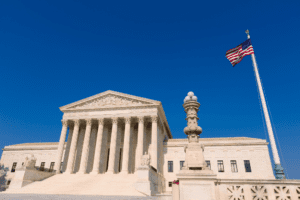 The dissent continued: On the contrary, “the fact that restrictions on public carry were well accepted in places like Massachusetts and were included in the relevant manuals for justices of the peace” suggests “that violations were enforced at the justice of peace level, but did not result in expensive appeals that would have produced searchable case law.” Id., at 131, n. 53 (citation omitted). The surety laws and broader bans on concealed carriage enacted in the 19th century demonstrate that even relatively stringent restrictions on public carriage have long been understood to be consistent with the Second Amendment and its state equivalents. E. Postbellum Regulation.
The dissent continued: On the contrary, “the fact that restrictions on public carry were well accepted in places like Massachusetts and were included in the relevant manuals for justices of the peace” suggests “that violations were enforced at the justice of peace level, but did not result in expensive appeals that would have produced searchable case law.” Id., at 131, n. 53 (citation omitted). The surety laws and broader bans on concealed carriage enacted in the 19th century demonstrate that even relatively stringent restrictions on public carriage have long been understood to be consistent with the Second Amendment and its state equivalents. E. Postbellum Regulation.
After the Civil War, public carriage of firearms remained subject to extensive regulation. See, e.g., Cong. Globe, 39th Cong., 1st Sess., 908 (1866) (“The constitutional rights of all loyal and well-disposed inhabitants to bear arms will not be infringed; nevertheless this shall not be construed to sanction the unlawful practice of carrying concealed weapons”). Of course, during this period, Congress provided (and commentators recognized) that firearm regulations could not be designed or enforced in a discriminatory manner. See ibid.; Act of July 16, 1866, §14, 14 Stat. 176–177 (ensuring that all citizens were entitled to the “full and equal benefit of all laws . . . including the constitutional right to keep and bear arms . . . without respect to race or color, or previous condition of slavery”); see also The Loyal Georgian, Feb. 3, 1866, p. 3, col. 4. But that by-now uncontroversial proposition says little about the validity of nondiscriminatory restrictions on public carriage, like New York’s.
What is more relevant for our purposes is the fact that, in the postbellum period, States continued to enact generally applicable restrictions on public carriage, many of which were even more restrictive than their predecessors. See S. Cornell & J. Florence, The Right to Bear Arms in the Era of the Fourteenth Amendment: Gun Rights or Gun Regulation? 50 Santa Clara L. Rev. 1043, 1066 (2010). Most notably, many States and Western Territories enacted stringent regulations that prohibited any public carriage of firearms, with only limited exceptions. For example, Texas made it a misdemeanor to carry in public “any pistol, dirk, dagger, slung-shot, sword-cane, spear, brass-knuckles, bowie-knife, or any other kind of knife manufactured or sold for the purpose of offense or defense” absent “reasonable grounds for fearing an [immediate and pressing] unlawful attack.” 1871 Tex. Gen. Laws ch. 34, §1. Similarly, New Mexico made it “unlawful for any person to carry deadly weapons, either concealed or otherwise, on or about their persons within any of the settlements of this Territory.” 1869 Terr. of N. M. Laws ch. 32, §1. New Mexico’s prohibition contained only narrow exceptions for carriage on a person’s own property, for self-defense in the face of immediate danger, or with official authorization. Ibid.
The dissent’s citations leave a lot of unanswered questions. For example, what was required for “official authorization” in New Mexico. What constituted “reasonable grounds” for fearing an attack in Texas. How is the Court’s analysis affected by the Texas law being a misdemeanor whereas New Jersey makes the unlawful possession of a handgun a second-degree felony with an enhanced, parole-ineligibility sentence.
